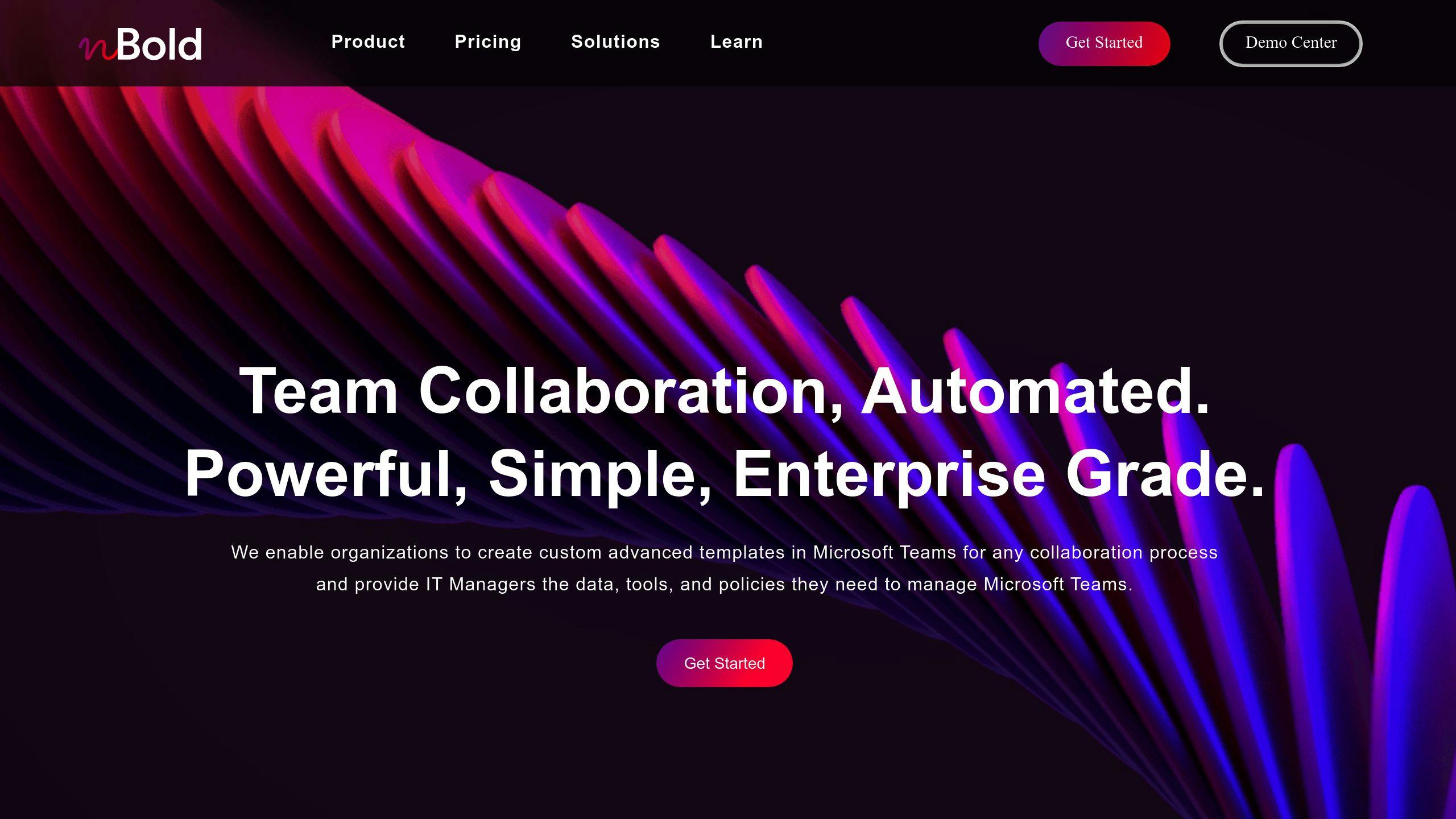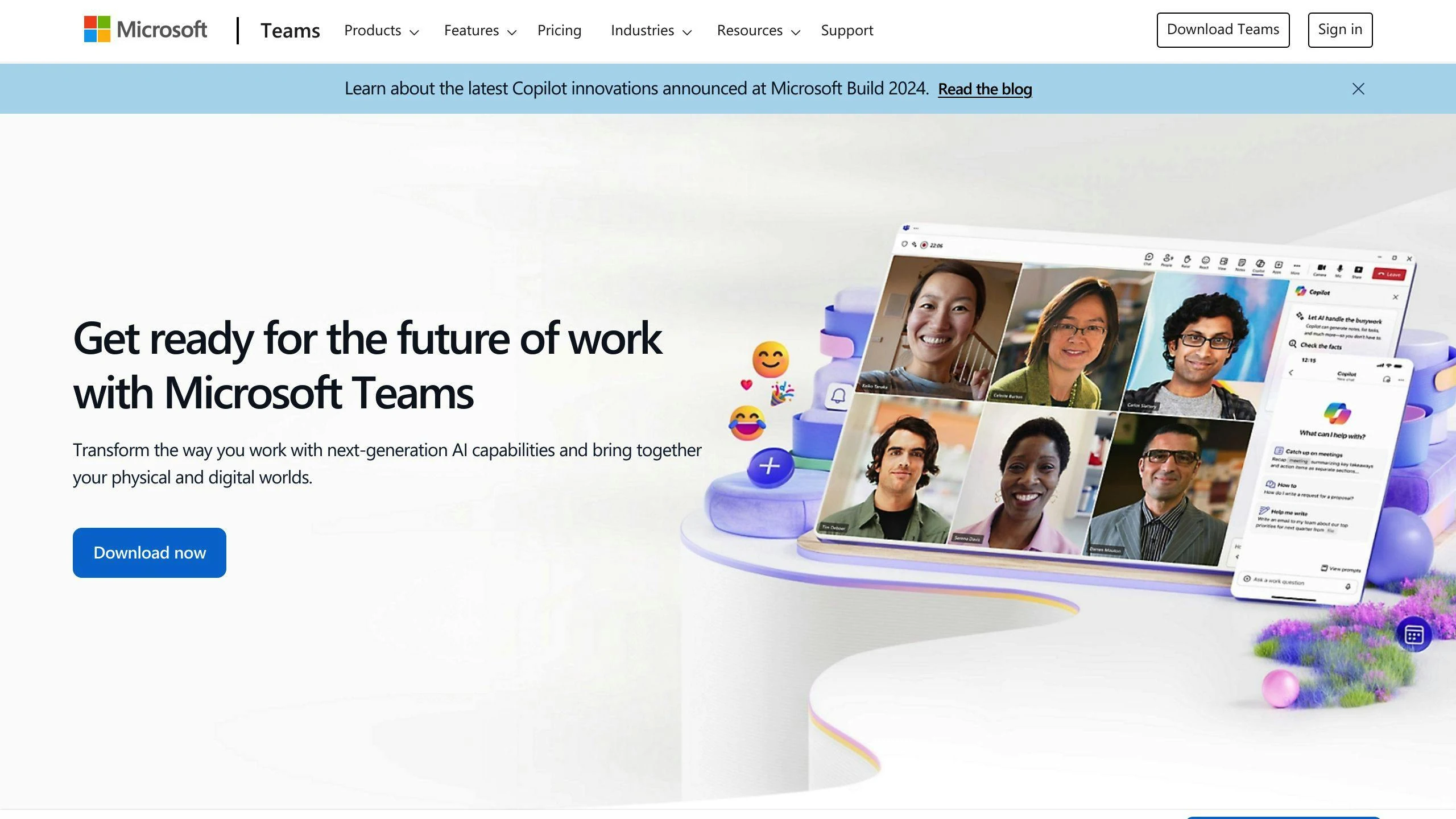Setting up custom analytics in Microsoft Teams can supercharge your organization’s collaboration. Here’s a quick guide to get you started:
- Access the Microsoft Teams admin center
- Navigate to Analytics & reports > View Reports
- Create a custom dashboard focusing on key metrics
- Connect with tools like Power BI for deeper insights
- Set up alerts for important changes
- Regularly review and adjust your dashboard
Key benefits:
- Track user activity and engagement
- Identify collaboration trends
- Optimize meeting efficiency
- Boost productivity across teams
Remember: Custom analytics takes about 24-48 hours to update, so be patient when first setting it up.
Quick Comparison:
| Feature | Built-in Reports | Custom Dashboard | Power BI Integration |
|---|---|---|---|
| Ease of Use | High | Medium | Low |
| Customization | Low | High | Very High |
| Data Depth | Basic | Intermediate | Advanced |
| Real-time Updates | No | No | Yes |
| Export Options | Limited | Moderate | Extensive |
By leveraging Teams custom analytics, you’ll gain valuable insights to drive better decision-making and improve your organization’s collaboration efforts.
Related video from YouTube
Before You Start
Let’s get you set up for custom analytics in Microsoft Teams. Here’s what you need:
Required Permissions
You’ll need one of these roles:
- Teams or Skype for Business administrator: Full access to all reports
- Global reader: View tenant-level aggregate data (no per-user or team data)
"To learn more about Teams admin roles and which reports each admin role can access, see ‘Use Teams administrator roles to manage Teams.’"
System Needs
Make sure you have:
- Visual Studio 2022: Version 17.3 or higher
- ASP.NET and web development tools: Selected in Visual Studio Installer
- Microsoft Teams development tools: Also in Visual Studio Installer
Teams Admin Center Access
To access analytics:
- Go to the Microsoft Teams admin center
- Select Analytics & reports in the left navigation
- Choose your report under View Reports
Needed Licenses
Here’s what you need:
| License Type | What You Get |
|---|---|
| Teams License | Basic Teams features |
| Teams Premium License | Advanced management and reporting |
| Viva Insights License (E5 plan) | Personal insights for employees |
| Separate Viva Insights License | Premium personal, manager, leader, and advanced insights |
Remember: Teams Premium doesn’t replace your regular Teams license. You need both.
"Teams Premium licenses are not a replacement for Teams licenses; users must have both a Teams license and a Teams Premium license for Teams and Teams Premium features to work properly."
Pro tip: Your tenant needs at least one user with an active Teams Premium license for admins to manage Teams Premium features.
Setting Up Your Dashboard
Let’s dive into creating your custom analytics dashboard in Microsoft Teams. This is where you’ll track and visualize your team’s collaboration data in a way that makes sense for your organization.
Finding Analytics Settings
Here’s how to get to the right place:
- Open the Microsoft Teams admin center
- Select Analytics & reports from the left menu
- Look for the View Reports section
This is where you’ll find all the data about how your organization uses Teams.
Built-in Dashboard Features
Teams comes with some solid analytics features out of the box. Here’s what you can see:
| Report Type | What It Shows |
|---|---|
| Teams usage | Active users, channels, messages, team privacy |
| User activity | Messages, calls, meetings organized and attended |
| Device usage | Users by platform (Windows, Mac, iOS, Android) |
| App usage | Active users and teams per app, total apps installed |
These reports are a good start, but to really dig into your data, you’ll want to create a custom dashboard.
Making a Custom Dashboard
Want to focus on the metrics that matter most to you? Here’s how to create a custom dashboard:
- Go to Analytics & reports in the Teams admin center
- Select Custom reports under View reports
- Click New custom report
- Name your report and choose a base report to start from
Pro tip: The Teams usage report is a great starting point. It gives you a broad overview that you can build on.
Using Dashboard Controls
Once you’ve got your custom dashboard, you can fine-tune it:
- Use the date range selector to adjust the time period
- Apply filters to focus on specific departments or locations
- Switch between chart types (bar, line, pie) to visualize your data
The goal is to create a dashboard that gives you useful insights at a glance. As Akshay Kothari, CPO at Notion, says:
"The best dashboards don’t just show data – they tell a story about your team’s collaboration and highlight areas for improvement."
Your dashboard should help you spot trends, identify issues, and make better decisions about how your team uses Teams.
Setting Up Your Metrics
Let’s dive into choosing and setting up the metrics that matter most for your organization.
Picking Data Sources
Microsoft Teams Analytics offers a goldmine of information. Here’s what you can tap into:
| Data Source | What It Tells You |
|---|---|
| User Activity | Messages sent, calls made, meetings attended |
| Team Usage | Active users, channels created, privacy settings |
| Device Usage | Platform preferences (Windows, Mac, iOS, Android) |
| App Usage | Popular apps and usage frequency |
Don’t stop there. Consider pulling in data from your project management tools or CRM system for a fuller picture.
Setting Measurement Rules
Think about your organization’s goals. Trying to boost collaboration? Improve meeting efficiency? Increase app adoption?
For meeting efficiency, you might track:
- Average meeting duration
- Number of participants per meeting
- Percentage of on-time meetings
As Jacob Morgan, author of "The Employee Experience Advantage", puts it:
"Understanding employee engagement through KPIs helps organizations create a thriving workplace culture. It’s not just about measuring; it’s about improving."
Creating Custom Goals
Set targets for your metrics. For example:
1. Increase active users by 20% in Q3
Track daily active users and aim for a 20% increase by quarter-end.
2. Reduce average meeting duration by 15% by year-end
Monitor average meeting length and work towards a 15% reduction.
3. Boost app usage by 30% in six months
Track which apps are being used and how often.
Making Calculation Rules
To track these goals, set up calculation rules:
- Go to Custom Metrics in the Setup section of your Teams admin center.
- Create a formula using standard and event-specific metrics.
- Name your metric, give it a unit, and set the direction.
For example, to calculate the percentage increase in active users:
(Current Active Users - Previous Active Users) / Previous Active Users * 100
Setting Update Times
Decide how often to refresh your dashboard. Weekly updates often strike a good balance between staying current and not getting overwhelmed.
Kathryn Minshew, founder and CEO of The Muse, notes:
"Tracking engagement KPIs allows organizations to proactively address issues before they become problems. It’s a powerful tool for creating a culture that employees want to be a part of."
sbb-itb-8be0fd2
Making Your Dashboard Work for You
You’ve set up your custom analytics dashboard in Microsoft Teams. Now let’s make it really shine.
Organizing Your Layout
A clean layout = quick insights. Here’s how to nail it:
Put your top metrics front and center. Group related data together. And use a grid for that pro look.
Picture this: "Daily Active Users" at the top left, with "Messages Sent" and "Meetings Attended" right below.
Want a simple two-column layout? Try this CSS:
.two-column {
display: grid;
gap: 20px;
grid-template-columns: 1fr 1fr;
}
Adding Charts and Graphs
Charts make data pop. Here’s how to add them:
- Hit the Configure button in the Data Viewer
- Pick your data source
- Choose Chart or Grid view
- Select your columns and chart type
Teams offers these chart types:
| Chart Type | Best For |
|---|---|
| Pie | Parts of a whole |
| Line | Changes over time |
| Bar | Category comparisons |
| Scatter | Variable relationships |
Setting Up Data Filters
Filters let you dig deep. To set them up:
- Go to dashboard settings
- Click "Add Filter"
- Pick the field to filter
- Set your criteria
Example: Filter "Messages Sent" by department to spot communication trends.
Creating Data Alerts
Don’t miss important changes. Set up alerts:
- Find the metric you want to track
- Click "Create Alert"
- Set your threshold and how you want to be notified
You could set an alert for when daily active users drop below 80% of your target.
Linking Dashboards
Want the big picture? Link your dashboards:
- Head to dashboard settings
- Hit "Link Dashboard"
- Pick the dashboard to connect
This is great for connecting overview dashboards with detailed ones.
Kevin Magarian, Principal Program Manager at Microsoft, shows how customizing dashboards (like the Scope 2 emissions one) can highlight what matters most to your org. This approach speeds up analysis and decision-making.
Remember: Your dashboard should work for YOU. Keep tweaking until it gives you the insights you need, fast.
Connecting Other Tools
Teams analytics gets even better when you hook it up with other tools. Let’s see how you can supercharge your data analysis and make your workflow smoother.
Using Power BI
Power BI is a game-changer for Teams analytics. Here’s how to connect it:
- Open Power BI in Teams
- Hit Create
- Pick Analyze your Teams data
Boom! You’ve got an auto-generated report that keeps itself fresh. It’s like having a personal data butler.
| Power BI Feature | What’s Cool About It |
|---|---|
| Interactive reports | Your Teams data comes to life |
| Data refresh | Always up-to-date, no manual work |
| Sharing | Team up on your analytics |
Kevin Magarian from Microsoft says:
"Tweaking dashboards in Power BI, like the Scope 2 emissions one, lets you spotlight what your company cares about. It’s like putting your data on steroids – decisions get made faster."
nBold Setup

nBold is like a Swiss Army knife for Teams analytics and control:
- Grab nBold from the Teams app store
- Cook up custom templates for your teamwork
- Set some ground rules with governance policies
| nBold Plan | What You Get |
|---|---|
| Pro ($3/user/mo) | Template Builder, Team Creation, IT Governance |
| CRM ($15/user/mo) | All Pro stuff + CRM Integrations |
nBold digs deeper into how you work together and puts your governance on autopilot. It’s like having a microscope and a robot assistant for your Teams data.
Other Report Tools
Teams plays nice with other analytics tools too. Check these out:
| Tool | What It Does |
|---|---|
| Productivity Score | Measures how well you’re collaborating |
| Workplace Analytics | Looks at how you communicate |
| SysCloud | Backs up and exports data automatically |
To plug these in:
- Head to the Teams admin center
- Go to Apps > Manage apps
- Find and install your tool of choice
Exporting Your Data
Sometimes you need to take your Teams data for a walk outside the platform. Here’s how:
- Use the Teams Export API for chat stuff
- PowerShell for automatic exports
- eDiscovery when you need to grab everything
Heads up: If your export’s over 10GB or has more than 25,000 items, you’ll get a nested ZIP file. It’ll hang around for 3 days, so don’t forget to grab it.
Fixing Problems
Setting up a Teams custom analytics dashboard isn’t always smooth sailing. Let’s look at some common issues and how to fix them.
Common Issues
Here’s a quick rundown of problems you might face:
| Issue | Solution |
|---|---|
| No data in user activity report | Wait 24 hours |
| Wrong data for posts and replies | Check for service issues |
| Slow dashboard | Optimize SQL queries and database |
| Analytics tab not updating | Restart Teams and sign in again |
If your user activity report is empty, don’t sweat it. Jennifer, a Teams user and Independent Advisor, says:
"Teams usage analytics can take up to 24 hours to update. If it’s still blank after that, open a support ticket with Office365 to check for server problems."
Speed Improvements
Slow dashboards are a pain. Here’s how to speed things up:
1. Optimize SQL queries
Filter first, join second, aggregate last. This order can make a big difference.
2. Use the right database
Move raw data to a database built for fast analytics queries.
3. Pre-filter and pre-aggregate
Create data views that are already filtered and summarized.
4. Cache query results
For data that doesn’t change often, save the results to avoid repeating the same queries.
Checking Data Accuracy
Getting the numbers right is crucial. Here’s what to check:
1. Licenses
Make sure users have the right licenses (like Microsoft 365 E3 or E5).
2. Reports
Check that the user activity report is turned on in Teams Admin Center.
3. Permissions
Even Global Admins might need extra permissions for reports.
4. Date ranges
Double-check you’re looking at the right time frame.
Managing Updates
Keep your analytics tools current:
- Set a schedule to check for Teams updates
- Turn on auto-updates if you can
- Always test new versions before rolling them out to everyone
Backup Steps
Don’t forget to protect your analytics data:
- Use the Teams Export API to save chat data regularly
- Set up PowerShell scripts for automatic exports
- Use eDiscovery for full data backups if you need everything
Wrap-Up
Custom analytics in Microsoft Teams can supercharge your organization’s collaboration and productivity. Here’s a quick rundown of how to make the most of your Teams analytics tools:
Built-in Reports: Your Starting Point
Microsoft Teams comes with several useful reports right out of the box:
| Report Type | What It Tells You |
|---|---|
| Teams usage | Who’s active, how many channels, message count |
| User activity | Messages sent, calls joined, meetings organized |
| Device usage | Who’s using what (Windows, Mac, iOS, Android) |
| App usage | Which apps are popular and where |
You can find these in the Microsoft Teams admin center. They’re a great place to start understanding how your team uses Teams.
Make It Your Own: Custom Dashboard
Want to take it up a notch? Create a dashboard that fits your needs:
1. Pick your metrics
Choose what matters to you. If you’re all about efficient meetings, track things like how long meetings last and how engaged people are.
2. Filter your data
Want to see how the marketing team is doing this month? Use filters to zoom in on specific groups or time frames.
3. Set up alerts
Don’t want to miss important changes? Set alerts. For example, get notified if fewer people are using Teams than usual.
Power Up: Connect with Other Tools
Make your analytics even better by linking Teams with:
- Power BI: Turn your data into cool, interactive reports.
- nBold: Get deeper insights into how people work together.
- Productivity Score: See how well your whole organization collaborates.
Keep Improving
Setting up analytics is just the start. Keep an eye on your dashboard and tweak things as you learn more. As Kevin Magarian from Microsoft puts it:
"Tweaking dashboards, like the Scope 2 emissions one, lets you spotlight what your company cares about. It’s like putting your data on steroids – decisions get made faster."
FAQs
Let’s tackle some common questions about Teams analytics to help you get the most out of this feature.
How to use Teams Analytics?
Using Teams Analytics is a breeze:
- Go to your team
- Click "More options" (…)
- Choose "Manage team"
- Hit the "Analytics" tab
- Pick your date range
That’s it! You’ll see a ton of data about your team’s activity.
| Data Point | What It Shows |
|---|---|
| Active Users | Team members engaging with content |
| Guests | External collaborators in the team |
| Total Messages | Overall team communication volume |
Keep in mind: data updates every 24-48 hours, so give it time to reflect recent stuff.
Does Microsoft Teams have Analytics?

You bet! Teams comes with built-in analytics that show you how your team’s working together. Here’s the scoop:
- Any Office 365 user who’s in at least one internal team can access analytics.
- You can check out stats for single teams or get a big-picture view across teams.
- Teams analytics track active users, guest activity, and how many messages are flying around.
Here’s a real-world example: A marketing team at Contoso Corporation used Teams analytics during a product launch. They saw a 40% jump in daily active users and 75% more messages in the week before launch. Talk about teamwork!
"Teams analytics have been a game-changer for us. It’s like having a finger on the pulse of our company’s teamwork", says Sarah Johnson, IT Director at Contoso Corporation.
Want to make the most of Teams analytics? Try this:
- Check your stats regularly to spot trends
- Use the data to make smart decisions about your team
- Compare different teams to find what works best
